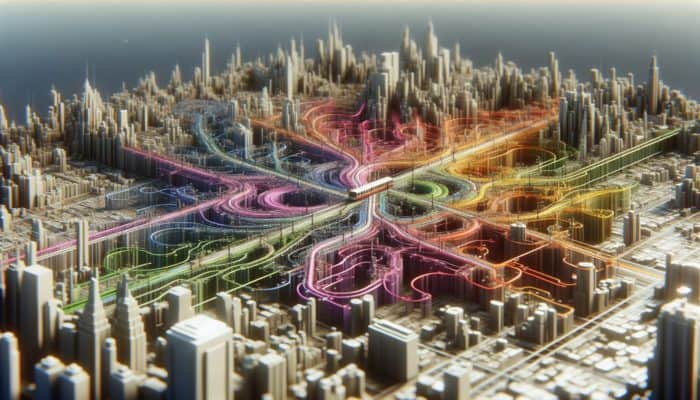Unlocking Effective Strategies for Navigating Public Transportation in Urban Environments
Navigating a bustling city can often feel daunting, particularly in a world brimming with diverse public transportation choices. Mastering the art of public transit not only elevates your travel experience but also instills confidence in your ability to explore new locales. By understanding transit maps, efficiently using mobile applications, and optimising fare systems, you can unveil the secrets to navigating urban landscapes efficiently. This ensures that each trip transforms into an enjoyable adventure, rather than merely a way to get from point A to B. Embracing these strategies enriches your journey and enhances your appreciation of the city’s vibrancy.
Improving Your Ability to Interpret Transit Maps

Transit maps may initially appear as intricate puzzles, yet developing the skill to interpret these maps is essential for any urban adventurer. Designed to distil complex transit systems into straightforward formats, these maps enable quick visualisation of your journey. Start by familiarising yourself with the layout of lines, stops, and transfer points. Many cities employ colour-coded lines, aiding rapid orientation and transforming what could be an intimidating task into an exciting challenge.
Take, for example, iconic cities like London, where the Tube map exemplifies the extensive underground network and highlights effective transit mapping. Learning to decipher such maps not only saves precious time but also alleviates confusion during your explorations. Regularly plan your route in advance, checking for necessary transfers or potential delays. Some transit systems even provide online area maps, allowing for thorough study before embarking on your journeys.
Understanding peak hours is also vital when navigating transit maps. Many urban areas face heavy congestion during rush hour, which can severely impact your travel efficiency. By identifying these peak times, you can strategically plan your trips during quieter periods, leading to a more pleasant and efficient travel experience. Always remember: within urban transportation systems, knowledge is a powerful tool that can enhance your journeys significantly.
Leveraging Mobile Applications for Real-Time Updates on Transit
The advent of technology has transformed the way we navigate urban landscapes. Mobile applications have become essential tools for modern explorers, offering real-time updates that can shield you from unexpected delays. Apps like Citymapper and Google Maps not only provide directions but also deliver live transit information, including delays or service interruptions that could affect your route.
By harnessing these applications, you can stay well-informed about your journey, enabling you to adjust your plans as needed. For example, if a train is delayed, you can swiftly explore alternative routes or modes of transit—perhaps opting for a bus or bike-sharing service. This flexibility is invaluable, especially in bustling cities where every minute counts.
Additionally, many of these applications allow you to save your preferred routes or commutes, simplifying navigation along commonly travelled paths. This feature is particularly beneficial in cities where you might be unfamiliar with the public transit layout. Real-time notifications regarding your chosen route can further enhance your journey, allowing for proactive time management and minimising stress.
Optimising Fare Systems for Affordable Travel Solutions
Gaining a comprehensive understanding of the fare systems in various urban areas can substantially improve your travel experience. Numerous cities have implemented smart card systems that streamline travel across multiple transit modes. Familiarising yourself with these systems can assist you in maximising savings while efficiently navigating the city.
For instance, cities like New York and Tokyo offer options for purchasing unlimited ride passes, which can significantly reduce costs if you plan on using public transportation frequently. Additionally, some cities provide discounts for pre-purchasing fare cards or for seniors and students, making travel even more economical.
Moreover, staying informed about available payment options—be it cash, contactless payments, or mobile wallets—can greatly enhance your travel experience. The last thing you want is to scramble for change when your bus arrives. By dedicating time to understanding fare structures, you can navigate confidently, avoiding unpleasant surprises during your urban adventures.
Mastering Urban Walking Techniques to Enhance Your Exploration

Walking is a fundamental and enriching aspect of urban navigation, offering a unique lens through which to experience city life and culture. Effective walking not only allows you to uncover hidden gems but also promotes physical activity while on the move. By selecting appropriate footwear, utilising pedestrian pathways effectively, and prioritising safety, you can excel in the art of city walking, no matter where your adventures take you.
Selecting the Right Footwear for Urban Exploration Adventures
The foundation of an effective walking experience begins with your choice of footwear. Selecting comfortable and durable shoes is critical for managing the varied terrains you will encounter in urban settings. Whether traversing cobblestone streets in historic European cities or navigating the asphalt of vibrant metropolises, the right shoes can significantly enhance your journey.
It is advisable to choose footwear that offers excellent arch support and cushioning, particularly if you plan to walk long distances. Sneakers or lightweight hiking shoes are often the best choices. When exploring cities like Paris, where you may cover considerable distances between attractions, comfortable shoes can transform a potentially exhausting experience into a pleasant stroll through charming streets.
Moreover, consider the weather conditions and pack accordingly. Waterproof shoes can be invaluable in regions prone to rain, while breathable materials are ideal in warmer climates. Ensuring your feet remain comfortable allows you to relish your urban exploration, free from the distraction of sore or fatigued feet at the end of a long day.
Utilising Pedestrian Pathways for Efficient Navigation
Modern cities are increasingly designed with pedestrians in mind, offering pathways and shortcuts that enhance walkability. Familiarising yourself with these pedestrian routes can give you a significant advantage when navigating crowded areas efficiently. Many urban environments feature dedicated pedestrian walkways, parks, and green spaces that provide peaceful routes away from bustling thoroughfares.
In cities like Amsterdam, pedestrian pathways are not only abundant but also often picturesque, with canals and lively street life enriching your experience. Use maps and mobile applications to uncover the best pedestrian routes, and don’t hesitate to explore off the beaten path—some of the most rewarding experiences can be found in lesser-known streets brimming with character.
Additionally, remain mindful of your surroundings while walking. Look for signage that directs pedestrians and indicates traffic patterns to ensure a safe and enjoyable journey. Maintaining a brisk pace can help you navigate through crowds while still allowing you to savour the local atmosphere and experience the unique charm of the city.
Prioritising Safety While Walking in Urban Areas

Safety is paramount when exploring urban landscapes on foot. Staying vigilant and aware of your surroundings can help you avoid potential hazards and elevate your overall experience. Familiarising yourself with local customs regarding pedestrian rights and traffic laws is essential for ensuring a smooth journey through busy streets.
Utilising crosswalks and adhering to traffic signals is crucial, especially in cities known for their bustling traffic. In high-density areas, be alert for cyclists and scooters sharing the road with you. Moreover, opting for well-lit and populated routes, particularly at night, can greatly enhance your safety while walking in unfamiliar neighbourhoods.
Another vital aspect of urban walking safety is protecting your belongings. Keep valuables secure and avoid displaying them openly, especially in crowded areas. Using a crossbody bag can help keep your hands free while ensuring that your possessions remain safe and secure. Remember, a little caution can go a long way in guaranteeing a safe and enjoyable walking experience in any city.
Leveraging Technology for Seamless Navigation in Urban Spaces
In today’s world, where technology shapes every aspect of our lives, navigation has evolved, incorporating advanced tools that enhance urban exploration. By employing GPS and mapping applications, adopting offline strategies, and integrating various technologies, you can navigate urban environments with unmatched ease and efficiency.
Utilising GPS and Mapping Applications for Accurate Navigation
GPS technology has transformed our navigation experience, providing turn-by-turn directions that are invaluable when exploring unfamiliar cities. Mapping applications, such as Google Maps or Waze, offer comprehensive routes that take into account real-time traffic conditions, empowering you to choose the most efficient path to your destination with confidence.
These applications prove especially beneficial when searching for local attractions, eateries, or essential services. By entering your desired location, you can receive tailored directions that accommodate your preferred mode of transport—whether walking, driving, or using public transit. Access to user-generated reviews and images further enriches your experience, enabling informed decisions about where to go and what to see.
Additionally, many GPS applications allow you to save your favourite locations, creating a personalised map of places you wish to visit. This feature can be incredibly useful during your travels, enabling you to revisit beloved spots or uncover new experiences based on previous trips and recommendations from friends or fellow explorers.
Implementing Offline Navigation Strategies for Consistency
Internet connectivity can be unpredictable while travelling, making offline navigation strategies essential for every urban explorer. Many mapping applications allow users to download maps in advance, ensuring access to crucial directions without depending on a data connection when you need it most.
Before embarking on your journey, take a few moments to download maps of the areas you plan to explore. This proactive approach guarantees that you won't find yourself lost without service in a new city, allowing for confident navigation. Offline maps typically include key points of interest and routes, enabling seamless navigation even when offline.
Additionally, consider carrying a physical map or guidebook as a backup. While technology is incredibly convenient, having a paper map can be invaluable in situations where your phone’s battery dies or connectivity is lost, ensuring you remain oriented and capable of navigating effectively.
Integrating Multiple Applications for Streamlined Navigation
The modern traveller has access to a multitude of applications designed to simplify navigation and enhance the exploration experience. By integrating various applications, you can optimise your urban journey. For instance, combining a mapping application with a local transit app can create a comprehensive travel plan, allowing seamless transitions between modes of transport as needed.
Furthermore, social applications that highlight local hotspots can be integrated into your navigation strategy. This enables you to discover not only the quickest route to your destination but also hidden gems recommended by fellow travellers. Whether it’s a charming café or an off-the-beaten-path attraction, incorporating these insights into your planning can significantly enrich your overall experience while exploring.
Keep in mind that some applications allow you to share your location with friends or family, enhancing safety during your travels. This feature can be particularly beneficial when exploring unfamiliar areas, providing peace of mind for both you and your loved ones.
Utilising Public Transport Applications for Enhanced Urban Navigation
Public transport applications have revolutionised the way we approach urban travel, providing real-time information that enriches your navigation experience. These applications specialise in delivering up-to-date transit schedules, routes, and alerts about delays or changes in service, making them vital tools for urban navigation.
Apps like Transit or Moovit are specifically designed for public transport users, offering insights into bus and train timetables, along with alerts about service interruptions. By utilising these tools, you can plan your journey more effectively, ensuring punctual arrival at your destination with minimal stress.
In addition to real-time updates, many public transport applications feature journey planners, which can suggest the best routes based on your preferences. For instance, if you prefer to avoid transfers or prioritise less crowded routes, these applications can help tailor your journey accordingly, enhancing your overall travel experience.
Smartwatch Features for Effortless Navigation
As technology advances, smartwatches have become powerful tools for urban navigation. With integrated GPS and a variety of navigation applications, your wrist can serve as a hub for receiving directions and alerts while keeping your hands free for other tasks, enhancing your overall travel efficiency.
Using a smartwatch for navigation allows discreet receipt of turn-by-turn directions. This can be particularly advantageous when walking in busy areas, as you can follow directions without constantly checking your phone. Additionally, many smartwatches provide vibration alerts for turns or route changes, ensuring you stay on track without distraction.
Moreover, the integration of fitness tracking features can motivate you to walk more, positively contributing to your overall well-being while exploring new cities. Monitoring your steps or activity encourages you to take the scenic route rather than relying solely on public transport, enriching your travel experience and allowing immersion in the local culture.
Understanding Urban Layouts for Efficient Navigation
A city’s layout profoundly influences how easily you navigate its streets and neighbourhoods. By recognising city grids, identifying key landmarks, and adapting to various urban designs, you can become a master navigator in any urban environment, enhancing your exploration experience.
Grasping City Grids for Improved Navigation
Many cities are structured with grid layouts that simplify navigation. Understanding these grid systems enables quick orientation and greater ease in navigating your surroundings. In cities like Manhattan, where streets and avenues form a predictable pattern, recognising this layout can prevent disorientation and save you valuable time during your explorations.
When traversing grid-style cities, familiarise yourself with the numbering system of streets and avenues. For example, in Manhattan, avenues typically run north to south while streets run east to west. This logical arrangement facilitates easier visualisation of your path, allowing confident navigation without confusion.
Furthermore, understanding how to estimate distances within a grid can assist you in gauging travel times effectively. If you know that a particular avenue is two blocks away, you can accurately assess how long it will take to walk there based on your pace, enabling efficient time management during your urban adventures.
Identifying Key Landmarks for Navigational Assistance
Prominent landmarks serve as vital reference points when navigating unfamiliar urban environments. By recognising these features, you can orient yourself and navigate with greater confidence. Landmarks can include iconic buildings, parks, monuments, or any distinctive structures that stand out against the cityscape.
For example, when exploring Paris, the Eiffel Tower serves as a recognisable point that can help you navigate the surrounding area effectively. Similarly, in New York, landmarks like the Empire State Building or Central Park can guide your journey. When you find yourself lost, looking for these structures can swiftly help you regain your bearings and continue your exploration.
Additionally, many cities have developed mobile applications that highlight these landmarks, providing historical context and guiding you to nearby attractions. Utilising these features not only aids navigation but also enriches your travel experience by imparting cultural insights and enhancing your understanding of the city's history and significance.
Adapting to Various Urban Designs for Enhanced Navigation
Urban environments come in a multitude of designs, each presenting unique navigation challenges. Understanding these differences is crucial for effective city navigation. Some cities, such as Paris, feature winding streets and historical layouts, while others, like Los Angeles, are expansive and geared towards vehicular travel, requiring different strategies for efficient navigation.
Adapting your navigation strategies to accommodate these designs can significantly enhance your urban experience. In cities with historical layouts, be prepared for unexpected turns and narrow alleys that may not appear on modern maps. Conversely, in sprawling cities, effectively utilising public transportation can save you time and energy while navigating long distances.
Moreover, embracing the local transportation culture can provide insights into effective navigation. For example, in cities renowned for their cycling infrastructure, like Copenhagen, becoming familiar with bike lanes and rental systems can transform your exploration experience, making it both enjoyable and efficient.
Maximising the Benefits of Taxis and Rideshare Services for Efficient Travel
Navigating urban environments often necessitates the use of taxis and rideshare services. Understanding how to select the right service, optimise pick-up and drop-off points, and navigate surge pricing can significantly enhance your travel efficiency and overall experience.
Selecting the Most Appropriate Service for Your Urban Travel Needs
Not all taxi and rideshare services are equal, and choosing the right option can greatly impact your urban navigation experience. Consider the factors that matter most to you—whether it’s cost, convenience, or wait times.
For instance, traditional taxis may be readily available in certain regions, while rideshare applications like Uber or Lyft can offer competitive pricing and a quick booking process. In busy cities, ridesharing is often preferred due to its ease of use and ability to track your driver in real-time, enhancing your overall travel experience.
Researching local options before your trip can also provide valuable insights. Some cities may have their unique rideshare services catering specifically to local needs or preferences. Understanding these differences ensures that you choose the most suitable option for your travel style and requirements.
Optimising Pick-Up and Drop-Off Points for Seamless Travel
Effective travel requires strategic planning, particularly when selecting pick-up and drop-off points for taxis and rideshare services. Choosing the right locations can minimise wait times and ensure a seamless travel experience.
When booking a ride, consider factors such as traffic patterns and busy intersections. Opt for pick-up points that are easily accessible for drivers, avoiding areas with heavy congestion. For example, during major events or festivals, it may be advantageous to select pick-up points slightly away from the main crowd, facilitating quicker access and a smoother experience.
Additionally, being aware of your surroundings can aid in effective communication with drivers. Providing specific landmarks or notable intersections can help eliminate confusion and streamline your pick-up process, ensuring you don’t waste time waiting unnecessarily.
Navigating Surge Pricing to Manage Transportation Expenses
Surge pricing can significantly influence the cost of rides during peak times. Understanding how this system operates can help you navigate urban areas without overspending. Rideshare companies typically charge higher fares during busy periods, such as rush hour or major events that heighten demand for their services.
To avoid surge pricing, consider scheduling your rides during off-peak hours or exploring alternative transportation options. Some applications allow you to monitor price fluctuations, enabling informed decisions about when to book your rides and save money in the process.
Additionally, consider pooling options, which can help reduce costs while still providing efficient transportation. Carpooling is not only budget-friendly but also environmentally conscious, making it an appealing choice for travellers seeking sustainable solutions while exploring urban landscapes.
Embracing Ride-Sharing Options for Enhanced Urban Navigation
Ride-sharing options can significantly enrich your urban navigation experience while simultaneously reducing costs and environmental impact. Services that offer carpooling or pooled rides enable multiple passengers to share a vehicle, providing a unique opportunity for savings and sustainability as you navigate through busy city streets.
By opting for these services, you can enjoy a comfortable ride while minimising your carbon footprint. Many rideshare applications incorporate pooling features, allowing you to select this option when booking. This not only saves money but can also foster a sense of community among travellers, connecting you with others on similar journeys.
In cities with heavy traffic or limited parking, pooled rides can also provide a strategic advantage. Sharing rides allows multiple passengers to reach their destinations while alleviating congestion on city streets. Embracing these ride-sharing options can enhance your travel experience while positively impacting urban dynamics, contributing to a more sustainable city environment.
Cycling as an Eco-Friendly Urban Transportation Alternative
Cycling has gained popularity as a sustainable mode of transport in numerous urban areas. By selecting optimal bike routes, understanding bike-sharing systems, and prioritising safety while cycling, you can navigate cities freely and easily, enjoying the dual benefits of exercise and exploration.
Selecting Optimal Bike Routes for Effortless Urban Exploration
Choosing the right bike routes can dramatically enhance your urban cycling experience, allowing for effortless exploration while enjoying the advantages of fresh air and exercise. Many cities have developed dedicated bike lanes that make cycling a safer and more enjoyable transport option.
When selecting routes, consider factors such as traffic patterns, elevation changes, and points of interest along the way. Many cycling applications provide insights into the best paths, highlighting bike-friendly streets and scenic routes. For instance, cities like Amsterdam and Copenhagen feature extensive networks of bike lanes that facilitate efficient and safe navigation for cyclists of all skill levels.
Before heading out, it’s wise to familiarise yourself with local cycling regulations and etiquette. Understanding how to interact with other road users—whether they be vehicles or pedestrians—can enhance your safety while reducing the risk of accidents, ensuring a more enjoyable cycling experience.
Getting to Know Local Bike-Sharing Systems
Bike-sharing systems have surged in popularity in urban environments, providing a flexible and convenient way to explore. Many cities have implemented bike-sharing programmes that allow users to rent bikes for short durations, offering an easy solution for quick journeys or sightseeing.
Familiarising yourself with the local bike-sharing system can be invaluable. Research how to rent bikes, the associated costs, and the locations of bike stations. Some applications can provide real-time availability, allowing you to locate nearby bikes rapidly and efficiently.
Additionally, consider the duration of your rental. Some systems charge by the hour, while others offer daily or weekly passes. Understanding these options enables you to choose the most cost-effective solution for your travel needs, ensuring you have access to a bike whenever you wish to explore the city.
Ensuring Safety While Cycling in Urban Areas
Cycling in urban environments necessitates a strong focus on safety to ensure a secure and enjoyable ride. Adhering to traffic laws, wearing appropriate gear, and maintaining awareness of your surroundings are crucial components of safe cycling practices.
Always wear a helmet, regardless of local regulations, to protect yourself in the event of an accident. Additionally, consider wearing bright or reflective clothing to enhance your visibility, especially when cycling during low-light conditions or at night.
Being attentive to road conditions and potential hazards, such as potholes or construction zones, is paramount for safe cycling. Stay alert for cars, pedestrians, and other cyclists, ensuring you maintain a safe distance while navigating through bustling city streets.
By adopting safe cycling practices, you can fully enjoy the freedom and efficiency of navigating urban landscapes on two wheels, discovering the city’s unique charm and hidden treasures along the way.
Navigating Urban Landscapes During Special Events
Special events can significantly alter the dynamics of urban navigation, presenting unique challenges and opportunities for exploration. By planning ahead, adapting to road closures, and utilising event-specific transportation options, you can navigate these situations with ease and fully enjoy the festivities.
Strategically Preparing for Special Events
Special events such as concerts, festivals, or parades can dramatically impact local traffic patterns and transit options. Planning your journey in advance can help you effectively navigate these changes, ensuring you arrive at your destination without undue stress or frustration.
Researching the event beforehand allows you to identify potential congestion points and alternative routes. Many cities provide information on expected attendance, road closures, and public transport adjustments to accommodate the influx of visitors. By staying informed, you can devise a strategy for your journey that accounts for these factors and helps you avoid unnecessary delays.
Moreover, consider arriving early to avoid the rush and secure a good vantage point for the event. This strategic approach allows you to fully enjoy the experience without anxiety over navigating through crowded streets, giving you the opportunity to soak in the atmosphere and connect with fellow attendees.
Effectively Managing Road Closures During Events
Road closures during special events can disrupt your travel plans, making it essential to adopt a flexible approach to navigation. Knowing how to manage these closures can help you maintain efficiency and reduce stress while navigating the city.
Before heading out, check local traffic updates or transit apps to identify closed roads and detours. Many navigation applications offer real-time updates regarding road conditions and alternative routes, enabling you to adjust your travel plans on the fly and avoid getting stuck in traffic.
Being adaptable is crucial when navigating around road closures. If you encounter a blocked route, don’t hesitate to reroute and explore alternative paths, as this can lead to unexpected discoveries and enriching experiences along the way, turning potential obstacles into opportunities for adventure.
Utilising Event-Specific Transportation Services for Convenience
Many cities offer special transportation services during major events to accommodate increased traffic and provide convenience for attendees. Utilising these services can enhance your overall experience, allowing you to navigate efficiently while avoiding congestion.
Public transport systems may implement additional services, such as shuttle buses or extended transit hours, specifically catering to the event's needs. Familiarising yourself with these options in advance can enable you to plan your journey effectively, ensuring you arrive on time and with minimal hassle.
Additionally, consider using rideshare apps that may feature designated pick-up and drop-off zones for events. This can streamline your transportation experience and alleviate the hassle of finding parking in congested areas, allowing you to focus on enjoying the event rather than worrying about logistics.
Frequently Asked Questions about Urban Navigation
What essential navigation tips should tourists be aware of in the city?
Understanding public transit, leveraging mobile applications for real-time updates, and familiarising yourself with the city’s layout are key strategies for smooth navigation and exploration in urban environments.
How can I optimise my experience using public transportation effectively?
Plan your route in advance, become acquainted with transit schedules, and consider purchasing unlimited passes if you intend to travel frequently throughout the city.
What should I wear when exploring a city on foot?
Opt for comfortable, supportive footwear suited for long-distance walking, and dress appropriately according to the local weather conditions to ensure a pleasant experience.
How do I ensure my safety while walking in an urban area?
Stay aware of your surroundings, stick to well-lit paths, and secure your belongings to guarantee a safe walking experience while exploring vibrant city streets.
What are the best apps for navigating cities efficiently?
Consider using Google Maps for directions, Citymapper for public transit information, and local apps tailored to specific cities for enhanced navigation and exploration.
How can I save money on taxis and rideshare services?
Choose pooling options, avoid peak hours, and utilise discounts or promo codes to reduce the cost of your rides while enjoying the convenience of rideshare services.
What should I know about bike-sharing systems before using them?
Familiarise yourself with rental processes, pricing structures, and docking station locations to maximise your bike-sharing experience and enjoy the freedom of cycling in the city.
How can I navigate road closures during events effectively?
Stay informed by checking local traffic updates, and have alternative routes planned to navigate around closures efficiently, ensuring you reach your destination without hassle.
What safety measures should I take when cycling in the city?
Wear a helmet, stay alert for traffic, and follow all traffic laws to ensure a safe cycling experience while exploring urban environments on two wheels.
How can I prepare for special events in the city?
Research the event’s details in advance, plan your transportation options, and consider arriving early to secure a good spot and avoid congestion while enjoying the festivities.
Discover our world on X!
The post City Navigation Tricks: Essential Tips for Urban Exploration appeared first on Survival Bite.
The Article Urban Exploration Tips: Essential City Navigation Tricks Was Found On https://limitsofstrategy.com


It’s fascinating to consider how mastering public transportation can truly transform our urban experiences. I remember my first solo trip to a major city, completely overwhelmed by the intricacies of its transit system. The maps looked like they were designed for an avid puzzle solver! However, once I took the time to familiarize myself with the layout and learn how to read the symbols and lines—much like learning a new language—the city felt like it opened up to me in a completely new way.